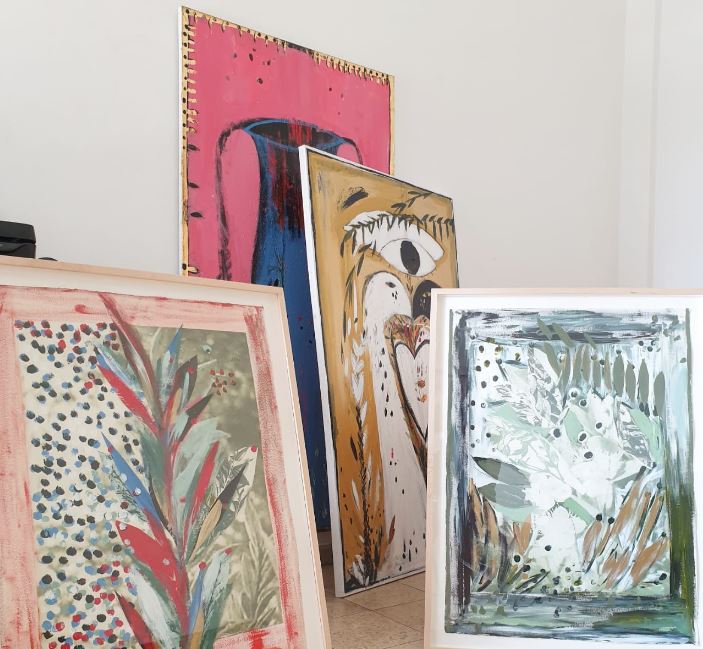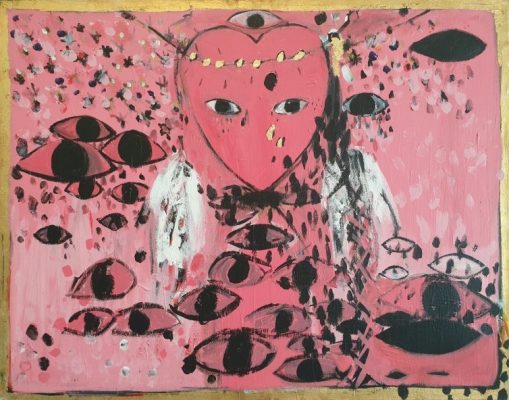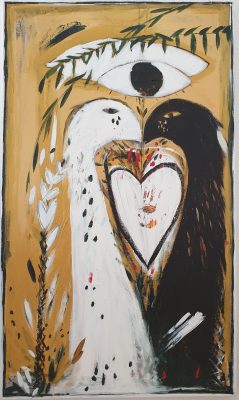An ethereal, otherworldly creature in striking pink hovers against the backdrop of a thick, green forest composed of lush brushstrokes on a small canvas. The mysterious angel boasts a heart-shaped head and an elongated form. Except for its slanted eyes, from which a few tears are flowing in harsh black, the weeping creature bears no other features that could help identify it as a human or a particular kind of animal. “What do you think about this one? Is he our friend or not yet? Something seems to be missing,” implores its maker, Israeli artist Khen Shish.
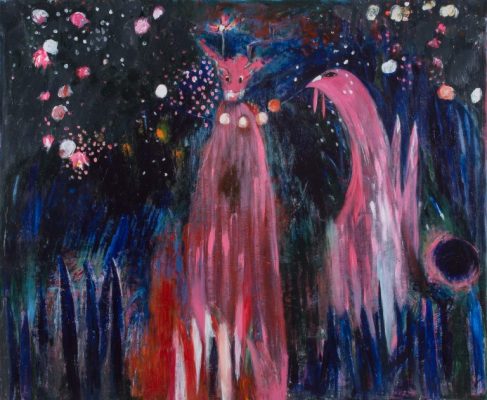 Khen Shish, The Magical Forrest and the Wild Animals, 2017
Khen Shish, The Magical Forrest and the Wild Animals, 2017
Shish, one of the most well-respected and prolific painters in the local scene, cocks her head and quickly glances back and forth between me and some open color tubes that are resting on the table in her Tel Aviv studio. “Your energy is very red,” she remarks abruptly. “That’s it, that’s exactly what we need here to make this one complete,” Shish exclaims in excitement and turns to dabble her thumb and forefinger in some red paint, which she proceeds to splatter in specks on the canvas. When I step closer to join her in front of the freshly altered painting, the somewhat stark but divine scene she has created seems to have gained more balance. “You see,” she turns to me and smiles in satisfaction. “I can’t explain it. I told you, when the moment is right I know. The painting just speaks to me.”
This quick exchange, during which the artist allowed me a peek into her creative process, is emblematic of Shish’s emotional and instinctive approach to her craft. Over the past three decades, she has created a body of work redolent with rich colors and enigmatic symbols that derive both from the world of nature as well as from Jewish mysticism.
Shish, a native of the northern Israeli city of Safed, has exhibited her painting and installation works extensively in solo and group exhibitions both in Israel and overseas. Each time she did, the artist was called upon to cite her sources of inspiration by critics and viewers, who were mystified by the charming but abstract visual codes that Shish embeds in her creations. In the past, she pointed at muses such as contemporary prose and poetry. Shish has also referred to her parents, Jews who immigrated to Israel from Tunisia, as harbingers of a lost cultural heritage that she attempts to revive in her art.
The pastoral countryside scenes of her youth and the Middle Eastern influences of her childhood home remain important pillars upon which Shish’s aesthetics rely. But presently, when Shish seeks inspiration she says that she finds it in the simplest if most elusive sentiment of all – love. “Inspiration moves in the same way that people move, in the same rhythm in which we mature and come into our own,” Shish reflects. “Right now, my inspiration is love. I am a loving person in my essence. That’s why I always paint hearts. Love is at the core of everything: My love for my daughter, my partner, for people at large, for food, for travel. My love for the miracle of painting. To me, the word love contains the whole world.”
Khen Shish, Pink Bride, 2019-2020
Seeing is believing
Shish’s art has a resonant quality to it that helps distinguish it from others in the contemporary scene. As we stand together in her studio, which also serves as her home, she shows me some of her most recent works.
Her latest paintings sport Shish’s confident painterly gestures and bold use of pink and gold. As I look at them, I share with her an observation: Part of the reason her works manage to penetrate the viewers is that they make up together a visual syntax that one has come to expect to find in them. I gaze at an enormous canvas on which she depicted two elegant, bird-like figures whose heads approach one another as they seem to be leaning in for a kiss. Shish’s black and white lovers are poised against a golden background, reminiscent of Byzantine-inspired mosaics in medieval churches. The gold setting renders the besotted birds timeless: They could be cooing lovingly at each other anywhere, anytime. But something about the beautiful, figurative tale is somewhat disturbing, too: Shish’s lovers are each marked by a tear-stained eye, and above them a large, third eye is drawn like an ominous sign.
Khen Shish, My Heart Explodes For You, 2019
“The eyes were the first motif that appeared in my paintings. They represent the glance. When I look at paintings, I feel that they look back at me. I see painting in a different way than you do, because each and every one of us has a different way of looking at things,” Shish explains.
“Another aspect that the eye motif stands for is my concern that I will lose my eyesight. I’m not talking just about the physical ability to see with your eyes, but also about the creative ability to look critically at one’s own painting and know when it’s ready or whether it requires more work,” the artist muses. “That’s an inexplicable ability. Look, you’re an art critic. Maybe you can’t paint, but you look at my paintings and understand them. So you know exactly what I mean, your eyes are an important tool. Without my eyes, I couldn’t paint.”
Asked why the eye motif continues to recur in her paintings while other imagery has come and gone, the painter says that she “doesn’t pay too much thought to it, because painting is something that just comes to me naturally. It’s like waking up and drinking coffee in the morning. I used to paint figures that looked like pregnant birds, I did that while I was pregnant with my daughter. After the pregnancy, I stopped painting them. It just makes sense this way, you know?”
Another visual cue that helps set apart Shish’s work from that of other painters is her strong palette. Unafraid of experimenting with the most extreme hues, Shish’s paintings are often imbued with black, green and her notorious hot pink. “I often fight with myself over the color scheme when I paint,” she shares. “Choosing to paint in pink can be kitsch, you have to use pink in a way that will make it look black. It’s something that happens on its own when I work. When I started painting, I didn’t realize that artists had to create their own unique world of motifs and colors, so mine were just born in the process as I worked in the studio.”
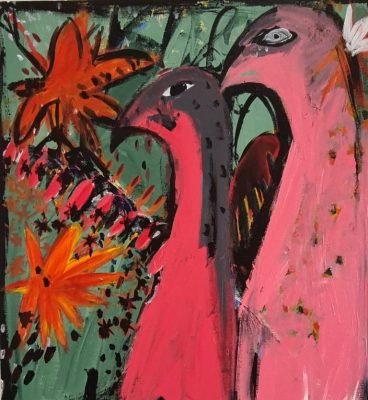 Khen Shish, Fall Leaves, 2020
Khen Shish, Fall Leaves, 2020
A suitcase by the door
Indeed, the studio is the place Shish refers to as “the lab where I play and have fun,” but one can’t help but think about the Freudian concept of the uncanny (i.e, the notion of a frightening strangeness that is suddenly recognized in a person’s familiar surroundings) while looking at the barren, stripped-down walls.
Shish’s studio has also been her home for the past 14 years. Prior to that the artist lived elsewhere and rented various studios. At the outset of her career, between studies for a BFA in art at the Art Institute in Oranim College and an MFA at the Bezalel Academy of Arts and Design, Shish traveled throughout Europe. It was there where she had developed the habit of painting from home, thereby turning her most intimate environment into a place of work and exploration.
“I was always used to working from where I live, and never feel quite at home anywhere,” Shish admits. “I never really wanted a home for myself. Up until my daughter was born, I always lived without furniture. It looked as though I were about to depart at any given moment, with a suitcase by the door.
To this day, when people come to visit me they’re not entirely sure what’s going on here, they think that it’s a very alternative kind of space. It makes me seem like a transient person, but that’s not true. I always have a bouquet of flowers here, no matter what, and there’s always food because I’m a great cook. To me, home is not about having furniture but rather about feeling that you have found peace.”
The influences of the nomadic lifestyle that Shish adopted are also palpable in her artwork: The gentle figures she paints are genderless and ageless, frozen in imaginary settings that are difficult to date or place within specific geographic locales. Add to that the decorative motifs that are reminiscent of Jewish ornamentation on prayer books and the casual insertion of Hebrew words here and there, and one might be tempted to re-read most of Shish’s oeuvres as visual journals of an immigrant.
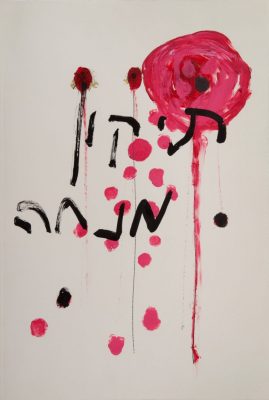 Khen Shish, Tikun Mincha, 2006
Khen Shish, Tikun Mincha, 2006
“I think about the notion of immigration all the time, it’s part of my journeys in the world,” Shish agrees. “I was always fascinated by the notion of wandering. My parents are both immigrants, so I think it’s part of my DNA to be one as well. I was never scared to move. From a very young age I traveled abroad, lived by myself and rented apartments alone. Even when I didn’t speak the local language wherever I lived, I always found a way to get along. It’s part of the survival instinct that every immigrant has.”
The idea of rapidly shifting from one place to the next has been expressed in Shish’s art before. In 1999, she began working on a project dedicated to the immigrant’s experience, which was later showcased at the Mishkan Museum in Ein Harod as part of an exhibition titled “Mother Tongue.” In it, Shish displayed postcards and letters that were based on two years during which she lived under the assumed identity of Djamila, an Arab immigrant from Tunis.
In the time that lapsed since that show, Shish’s interest in the topic hasn’t waned, but today it translates itself more subtly into her work. “I have moments when I feel more like an immigrant, so I make sketches or work on paper. Other times I feel heavier and more matronly, and then I choose to work with oil or acrylic on canvas. Art is who you are, it reflects how you see yourself in the world.”
Negotiating with the painting
The sense that she is perpetually wading into new territories guides Shish in her technical pursuits at the studio, where she is compelled by the notion that “anything could happen. I can make a cup of coffee, some of it spills and leaves a stain, and suddenly it sparks inspiration.”
Her latest exhibition, on view at the Ticho House Museum in Jerusalem, came to be in a similar manner. A decade ago, she began experimenting with spreading ink on paper and letting it spread out across the surface until it moulded into new forms. She recently returned to this technique, folding the papers she had worked on in two and then altering the stains of ink and manipulating them with her fingers until she arrived at the desired shape and consistency she was looking for.
The final result is a series of inkblot paintings titled “Looking for a Beautiful Heart,” which was displayed alongside larger paintings in the show. The reviews lauded the works as a surprising foray by Shish into a new, abstract phase, reminiscent of Rorschach stains in standardized psychological tests.
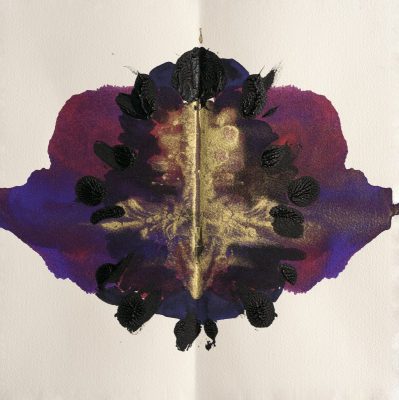 Khen Shish, Looking for a Beautiful Heart, 2019
Khen Shish, Looking for a Beautiful Heart, 2019
I tell Shish that both the series’ name and its modest size gave the paintings a certain agility that was both tactile and musical. When I stood in front of them I had recognized Shish’s iconic heart motif in the outlines of the amorphous stains. I also couldn’t look at them without thinking of the lyrics of Neil Young’s “Heart of Gold,” in which the Canadian singer-songwriter describes that he has “been searching for a heart of gold, and I’m getting old.”
Shish smiles softly and thanks me when I share with her my associations. “In this series, I’ve seemingly created the abstract at its most extreme form. Nonetheless, different people have told me that they detected in these drawings various forms: Leaves, flowers, birds, owls, vaginas. I called it ‘Looking for a Beautiful Heart’ because that is what I am seeking through these works – I’m looking for the viewers’ beautiful hearts, for their generosity. I want them to approach these works openly and seek beauty in them, regardless of what form they might find in them. And once they do, I want the viewers to bring their hearts into this beauty.”
Shish pauses to ponder the long personal and creative journey that has led her to create these works. “When I say that I’m looking for a beautiful heart, I really mean that I’m asking for generosity. I’m asking it of my partner, of my daughter, of people who see my art, of these walls that surround me when I work. I really ask the papers I work with: Please give in to me, don’t be heavy. It’s like a negotiation with the painting, and I ask it to let me in.”
Discover & Collect Khen Shish’s works here
Joy Bernard is a senior news editor at Israel’s leading English-language daily Haaretz. Based in Tel Aviv, she writes about politics, arts and culture in the Middle East for various publications.

